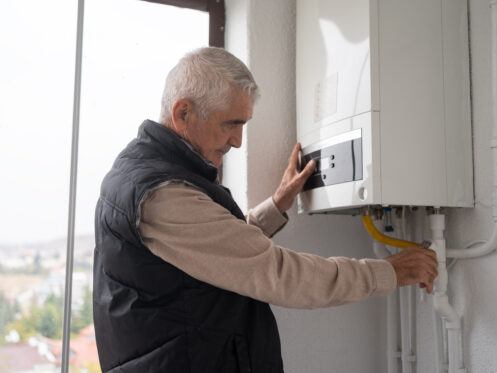Tankless water heaters are also referred to as instantaneous or on-demand water heaters. These appliances only provide water when needed. Unlike their traditional counterpart, they do not store heated water until used. Because of the on-demand nature of a tankless water heater, they can save a lot of energy.
How Do Tankless Water Heaters Work?
Tankless water heaters heat water immediately without the use of a storage tank. When you turn on the faucet for hot water in your shower or sink, water from your well or municipal supply travels through the heat exchanger in the tankless unit. Then, a gas burner or an electric element heats the water.
With this technology, you receive a constant supply of hot water. There is no need for a storage tank to fill up with hot water. However, tankless water heaters output water at a predetermined flow rate.
A tankless water heater usually produces between two and five gallons of heated water per minute. Electric-powered tankless water heaters produce water at a lower flow rate than gas ones.
Even the largest gas-model tankless water heaters do not produce enough water for multiple simultaneous uses in a large home. For example, you may not be able to take a shower and run the dishwasher at the same time.
To address this limitation, you can install multiple tankless water heaters in your home or a separate tankless water heater for larger appliances like your washing machine or dishwasher. However, installing numerous units can be expensive, and the convenience may not justify the additional cost.
Factors to Consider Before Installing a Tankless Water Heater
Several factors should be considered if you are considering replacing your traditional water heater with a tankless one. First, the temperature of the groundwater where you live plays a crucial role. In northern states, groundwater temperatures typically range between 35°F and 45°F, while in southern regions, it can be as high as 70°F. Calculate the difference between the average groundwater temperature and your desired output temperature for hot water in your home, which typically falls between 100°F and 115°F.
Second, the flow rate needed should be determined in gallons per minute. Consider all the appliances that will receive water from your tankless water heater and anticipate simultaneous usage scenarios, such as running the washing machine while taking a shower. This will help determine the appropriate flow rate for your home. Consult with your plumbing technician to ensure that the tankless heater installed is the right size for your home and water usage requirements.
The Advantages of a Tankless Water Heater
Saving Space
Tankless hot water heaters are smaller than traditional tank models. They do not require a large tank. These compact on-demand units are around the size of a suitcase and can be mounted on a wall to free up space in the home. On-demand hot water heaters can be installed inside or outside the home, like a garage, basement, or closet. This maximizes the square footage of usable space in your home.
Providing an Endless Hot Water Supply
One of the standout features of a tankless water heater is that it only heats water when the faucet is turned on. Water in the tankless unit is heated as it is delivered, eliminating the issue of using up all the hot water in the tank. This delivery method means that in a home with several occupants, multiple people can take a shower consecutively on a busy morning, and all of them will have hot water.
Longer Lasting Units
Tankless hot water heaters have a lifespan that is up to two times longer than traditional tank water heater models. While the initial expense of installing them is higher, you will save money on replacement costs.
Energy Efficiency
Tankless water heaters are more energy efficient compared to tank models. Traditional tank heaters constantly reheat water, even when not in use, consuming a lot of energy. In contrast, tankless water heaters only heat water when the faucet is turned on, eliminating the expense of keeping a large volume of water constantly hot. This results in up to 50 percent less energy usage than tank units, less water wastage, and a lower carbon footprint.
The Downsides of a Tankless Water Heater
Although there are several benefits of tankless water heaters, some limitations may lead you to consider whether this unit is the right choice for your home.
Cost
The purchase price of a tankless water heater is higher than that of a traditional unit. It may also be expensive to reconfigure plumbing to accommodate your new water heater. However, you may recoup some of these expenses over the unit’s lifespan through energy savings.
Limited Flow Rate
Reduced flow rates can result in poor heating and low-temperature water. Before installing a tankless water heater, consult with your plumber to determine the appropriate flow rate for your home. Remember that in many cases, higher flow rates correspond to higher costs for the water heater.
Need to Install Multiple Units
Larger homes with large families often have higher demands for hot water. Even a larger unit may not meet this demand adequately. Therefore, you may need to install multiple tankless water heaters to ensure that all the water in the home is heated to the optimal temperature.
Inconsistent Temperatures
Another downside of tankless water heaters is their tendency to produce inconsistent water temperatures. The water temperature can vary based on the flow rate, and during periods of high demand, when multiple water-using appliances are operating simultaneously, it can drop significantly.
Power Outage
Tankless water heaters, even those fueled by gas, require electricity to run. In a power outage, you will have no hot water. Therefore, if you live in an area with frequent power outages, a tankless water heater may not suit your needs.
Is It Worth It Switching to a Tankless Water Heater?
Whether it’s worth switching to a tankless water heater depends on various factors. Tankless heaters offer significant energy savings, ranging from up to 34% for households using 40 gallons a day and between eight and 14% for those using upwards of 80 gallons per day.
Additionally, tankless systems generally have a longer lifespan, providing added value over time, especially for homeowners planning to stay in their current residence indefinitely. However, the decision to switch depends on several considerations, including your location, hot water usage patterns, and whether any significant modifications to your home’s infrastructure are required. Evaluating these factors will help determine whether a tankless water heater is worth it for you in the long run.
Plumbing Services You Can Trust in Los Angeles and the Surrounding Area
At Bobby L Greene Plumbing, Heating & Cooling Co., we are committed to providing quality service, home efficiency, and trustworthy work to the residents of Shreveport, LA. Regardless of the type of plumbing service you need, our team of experienced contractors can help. We’ve been in the industry since 1959 and are your one-stop solution for all of your home’s plumbing needs.
Our services include leak detection, garbage disposals, kitchen plumbing, HVAC services, water heater installation, drain and sewer inspection and repair, and water filtration systems. Contact Bobby L Greene Plumbing, Heating & Cooling Co. today to schedule an appointment with one of our professionals.

